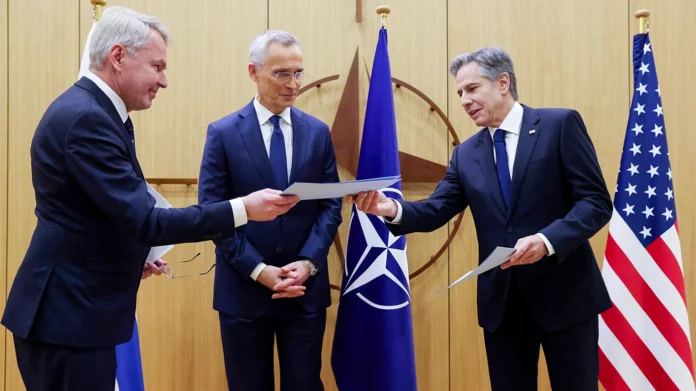Finland officially joined the NATO alliance last week to great fanfare after a year-long accession process marked by a distinct lack of debate. The Nordic country, nestled between Sweden and Russia, long has championed a neutral foreign policy, but as Russian forces surged across Ukraine’s eastern border in February 2022, public opinion in Finland shifted dramatically toward support for NATO membership. While Finns may believe this decision bolsters their national security, Americans should question how defending yet another European ally — particularly one that shares an 830-mile border with Russia — is in the U.S. interest.
One would think that the consequential decision of committing U.S. troops to fight and die for another country would warrant rigorous debate in Congress. However, that debate was largely nonexistent last summer when the proposal was brought to the floor of the Senate, with only one senator — Josh Hawley (R-Mo.) — voting against further NATO expansion. With Finland now firmly under NATO’s Article 5 guarantee that states an attack on one member is an attack on all members, the best strategic outcome for the United States is to use this moment as an inflection point to transform a one-sided trans-Atlantic relationship to become more equitable.
The initial shock of Russia’s invasion of Ukraine seemed to wake Europe up from its complacency in regard to security matters. German Chancellor Olaf Scholz made an impassioned speech in the Bundestag, calling the moment a “Zeitenwende,” or turning point in Europe’s history. However, 14 months later, only seven NATO countries, including the United States, spent 2 percent of their GDP on defense — a reduction from nine countries in 2021. The 2 percent spending target was agreed upon by all NATO members in 2014, yet nearly a decade later it remains unfulfilled by 23 members — all while the largest conflict since the Second World War rages on European soil.
Germany, the continent’s strongest economic power, remains woefully unprepared to play a leading role in Europe’s defense. Not only is Germany predicted to miss the 2 percent spending mark yet again, but its armed forces are severely undermanned, undersupplied and under-equipped, with reports claiming it only maintains enough ammunition to last for two days of fighting. Germany’s new defense mMinister, Boris Pistorius, recently commented that continued shortages are to be expected until 2030.
European NATO allies seem content with the continuation of the status quo for two reasons. First, the Biden administration has retrenched American military might in Europe, surging an additional 20,000 troops, bringing the total to 100,000 stationed across the continent. The United States, despite the protestations of U.S. presidents for decades for Europe to pick up the slack, remains committed to using American blood and treasure to ensure European security. Second, Russia’s abysmal military performance in Ukraine proves its conventional weakness. A Russia that cannot conquer Bakhmut, let alone Kyiv, does not pose a conventional threat to Warsaw, Berlin or Paris.
With a $31 trillion national debt and a rising superpower competitor in China, the United States no longer can afford to be Europe’s sole defender. Washington, therefore, must take tangible steps to ensure European allies assume the primary responsibility of providing for their own defense. This would entail working with European allies on an agreed upon timetable to withdraw U.S. forces, transfer responsibilities to European militaries, and allow the Europeans to develop capacities they rely on the United States to provide, such as command and control, intelligence, surveillance and reconnaissance, and strategic lift. Simply demanding Europeans do more has proven not to affect change. Without taking the step to actually bring U.S. forces home, there is little to no incentive for European allies to make the necessary trade-offs needed to spend on costly defense investments.
For its part, Finland can be a model example of this transfer of responsibility. With a population of just 5.5 million, Finland maintains a small, but well-equipped professional military. Finland’s defense strategy focuses on the threat posed by its neighbor and historical adversary, Russia. Informed by its experience during the Winter War of 1939, where vastly outnumbered Finnish forces resisted a Soviet invasion, Finland prides itself on self-sufficiency and a whole-of-society approach regarding defense. It is one of the few remaining European states following the Cold War to maintain a conscription program, with a reserve pool of upwards of 900,000 soldiers. Finland’s location also lends itself to assume the leading responsibility of aiding the Baltic states should they be attacked — an issue that long has challenged NATO defense planners.
Finland’s acceptance into the alliance increases Europe’s aggregate military power further, reducing even more so the need for the United States to do all the heavy lifting. Helsinki’s continued prioritization of defense and its high standard of living should serve as an example for other wealthy European states on how to move forward without U.S. hand-holding. With Russian weakness exposed by its bungled war in Ukraine, and the United States facing more pressing issues domestically and in Asia, the time is ripe for Europe to defend itself.
Source : The Hill

